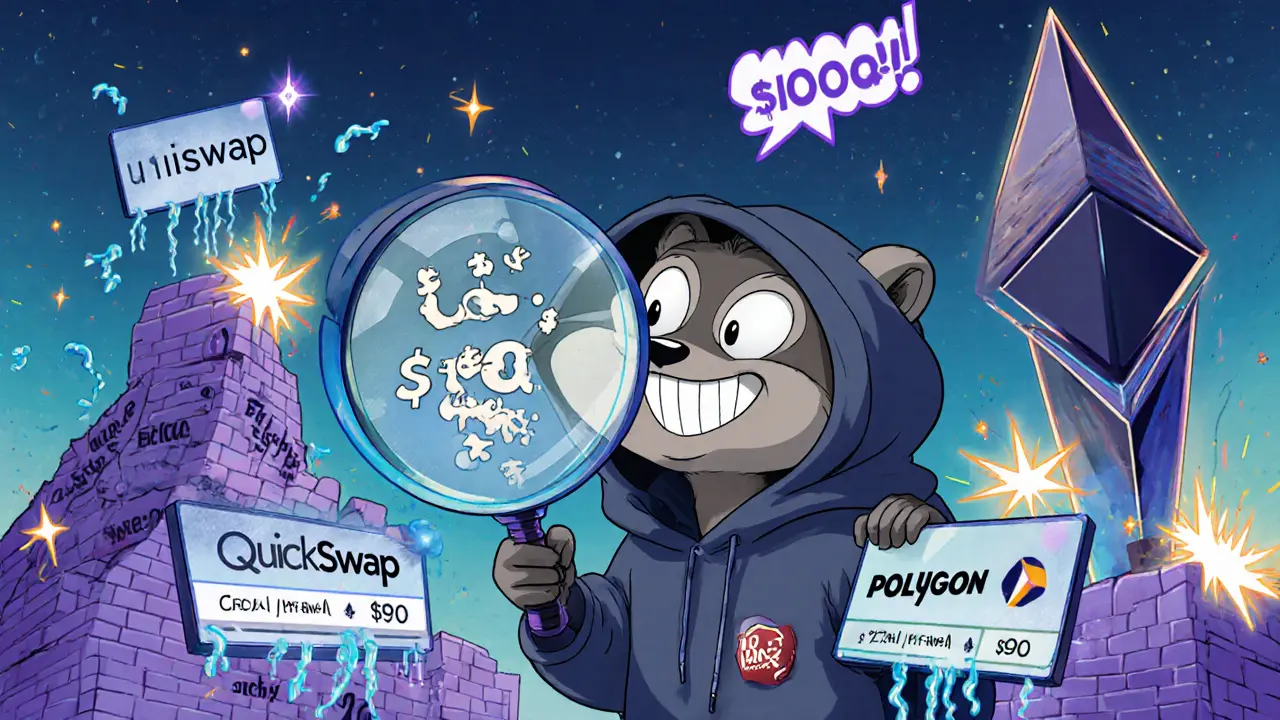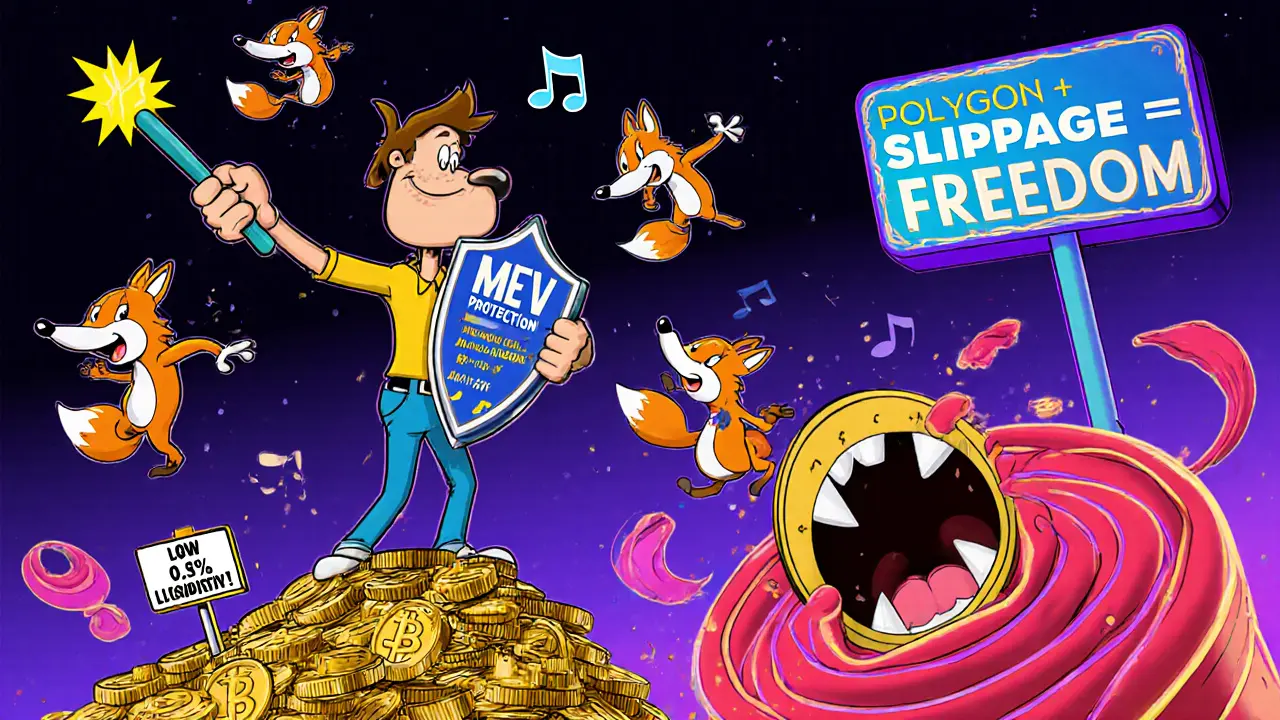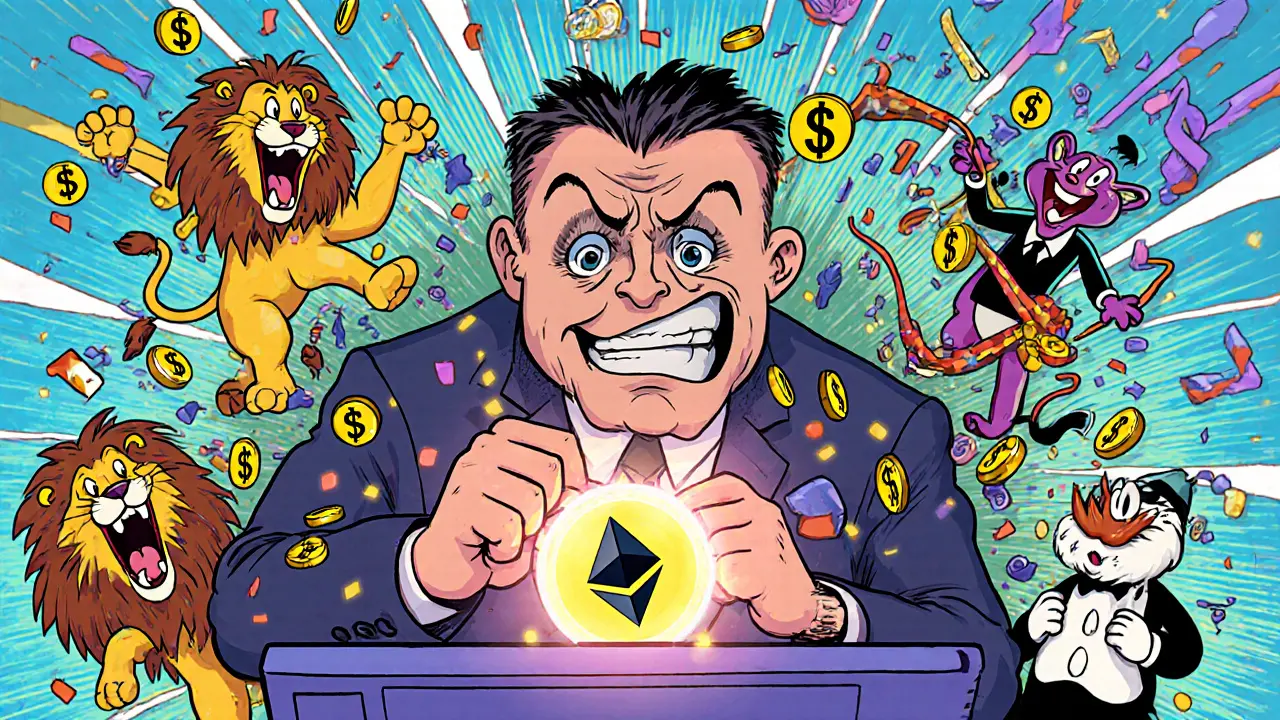DEX Trade Cost Calculator
Trade Details
What You’re Actually Paying When You Trade on a DEX
When you swap ETH for USDC on a decentralized exchange, you might think you’re only paying a 0.3% fee. But that’s just the tip of the iceberg. In 2025, the real cost of trading on a DEX includes DEX fees, gas charges, slippage, and sometimes hidden routing costs. For small trades, these hidden costs can eat up 5%, 10%, or even more of your capital. Most new traders don’t realize this until their trade executes at a much worse price than expected-or their wallet gets drained by Ethereum gas fees.
How DEX Fees Actually Work
Unlike centralized exchanges like Binance or Coinbase, where fees are flat and clear, DEX fees are layered. Every trade has at least two costs: the protocol fee and the gas fee.
The protocol fee is built into the DEX smart contract. Most major DEXs like Uniswap, ORCA, and QuickSwap charge 0.30% per trade. But not all are the same. On Aerodrome (Base), stablecoin pairs like USDC/USDT cost just 0.02%. Volatile pairs like SOL/ETH? That jumps to 0.20%. This tiered model rewards liquidity in stable pairs and charges more for riskier trades.
Here’s how the 0.30% fee breaks down on most platforms:
- 0.25% goes to liquidity providers (LPs) who supply the tokens you’re trading against
- 0.05% goes to the protocol treasury-used for development, incentives, or token buybacks
That means if you trade $1,000 on Uniswap, $3 goes to fees. But $2.50 of that isn’t going to the exchange-it’s going to random strangers who locked their crypto in a pool. You’re paying them to make your trade possible.
Gas Fees: The Wild Card
Protocol fees are predictable. Gas fees? Not so much.
On Ethereum mainnet, a simple swap can cost $50-$100 during peak hours. That’s not a typo. If you’re trading $200 worth of tokens, your gas fee is 25-50% of your entire trade. No wonder people are leaving Ethereum for layer-2s.
Here’s what gas looks like across networks in late 2025:
| Network | Avg. Gas Fee | Speed | Best For |
|---|---|---|---|
| Ethereum Mainnet | $50-$100 | 15-60 sec | Large trades, institutional use |
| Polygon | $0.10-$0.50 | 2-5 sec | Small trades, frequent swaps |
| Arbitrum | $0.20-$1.00 | 3-8 sec | High liquidity, low slippage |
| Solana | $0.01-$0.05 | 0.4 sec | Speed-focused traders, meme coins |
Many traders now use Polygon or Arbitrum for daily swaps. Solana’s ultra-low fees make it ideal for high-frequency trading, but its occasional outages make it risky for large positions.

Slippage: When Your Trade Doesn’t Execute as Expected
Slippage is the difference between the price you see when you click ‘Swap’ and the price you actually get. It’s not a fee-it’s a price impact. And it’s worse than you think.
For popular pairs like WETH/USDC on Uniswap, slippage is often under 0.1%. But for new tokens with low liquidity? You could easily see 1%, 3%, or even 10% slippage.
Imagine you want to buy 1,000 tokens of a new memecoin priced at $0.01. You set your slippage tolerance at 5%. The DEX shows you’ll get 100,000 tokens. But because there’s barely any liquidity, the price moves as your trade executes. You end up paying $0.011 per token. You get only 90,909 tokens instead of 100,000. That’s a 9.1% loss before you even consider gas.
High slippage happens because:
- Low liquidity pools can’t absorb large orders
- MEV bots front-run your trade, buying ahead of you and driving up the price
- Market volatility spikes during news events or whale movements
Uniswap v3’s concentrated liquidity helps. Instead of spreading tokens across a wide price range, LPs focus liquidity around the current price. This reduces slippage by 30-60% for active trading ranges. But it’s complex-most retail users still stick with v2.
Aggregators: Your Secret Weapon Against Slippage
Instead of trading on one DEX, aggregators like 1inch, Matcha, or Paraswap scan dozens of pools across Ethereum, Polygon, Arbitrum, and Solana. They find the best price and split your trade across multiple sources.
For example: You want to swap 500 USDC for DAI. Uniswap offers 498 DAI. QuickSwap offers 499.5. Then 1inch finds a pool on Curve offering 500.8 DAI and splits your trade 60/40 between Curve and QuickSwap. Result? You get 500.8 DAI-better than any single DEX.
Aggregators also optimize for gas. They’ll route your trade through a cheaper network if it saves you money overall. Many include built-in slippage protection and MEV shields.
For anyone trading more than $100, using an aggregator isn’t optional-it’s essential.
Why DEXs Still Win (Even With High Fees)
So why bother with DEXs when Binance charges 0.1% and no gas?
Because you control your keys. No KYC. No frozen accounts. No exchange going bankrupt and taking your Bitcoin. Your wallet holds your assets-always. That’s priceless for many traders.
Also, DEXs offer access to tokens you can’t buy anywhere else. New DeFi projects launch on DEXs first. If you want early exposure to a token before it hits Coinbase, you need to trade on Uniswap, SushiSwap, or Raydium.
And for large traders? DEXs often have better price impact than centralized exchanges, especially for illiquid assets. On Binance, big orders get slippage too-but you don’t see it. On DEXs, you see the slippage, you control it, and you can adjust it.

How to Trade Smarter on DEXs in 2025
Here’s what works for real traders right now:
- Use layer-2 networks for everyday trading. Polygon and Arbitrum cut gas costs by 99% compared to Ethereum.
- Never set slippage above 1% unless you’re trading a token with known low liquidity. Start at 0.3% and only increase if the trade fails.
- Always use an aggregator for trades over $100. 1inch or Matcha will save you money and time.
- Trade during low congestion. Avoid Ethereum during peak hours (UTC 14:00-18:00). Use tools like Etherscan’s gas tracker.
- Watch for MEV. Some wallets (like Rabby or MetaMask) now include MEV protection. Turn it on.
- Don’t trade new tokens with under $500k in liquidity. They’re slippage traps.
The Future: Gasless Trades and AI Routing
Uniswap v4 is rolling out batched transactions, which could cut gas by 40% for users doing multiple swaps. Account abstraction (ERC-4337) is letting wallets pay gas in tokens instead of ETH-so you don’t need ETH just to pay fees.
AI-powered routing tools are emerging. Some bots now predict slippage based on order book depth, whale movements, and MEV patterns. They auto-adjust slippage and choose the cheapest network in real time.
Regulation is coming. The EU’s MiCA rules and U.S. SEC guidance are pushing DEXs to add compliance features. That might mean KYC for large trades-but it could also bring more institutional liquidity, which lowers slippage for everyone.
Final Thought: It’s Not About Cheapest-It’s About Control
DEXs aren’t cheaper than centralized exchanges. Not even close. But they’re more transparent. You see every fee. You control every trade. You’re not trusting a company-you’re trusting code.
For most people, the right move is simple: Use Polygon or Arbitrum with 1inch. Set slippage to 0.5%. Avoid new tokens. And never, ever trade on Ethereum mainnet unless you’re moving $10,000+.
The cost is high. But the freedom? That’s priceless.
Are DEX fees higher than centralized exchange fees?
It depends. The protocol fee on a DEX (0.02%-0.30%) is often lower than a centralized exchange like Coinbase (1%+). But when you add Ethereum gas fees ($50+), your total cost can be 10x higher. On layer-2 networks like Polygon, DEX fees are cheaper than most centralized exchanges for trades under $1,000.
What’s a safe slippage tolerance for trading on a DEX?
For major pairs like ETH/USDC or BTC/USDT, 0.3% is safe. For stablecoins (USDC/USDT), you can go as low as 0.1%. For new or low-liquidity tokens, never go above 1%. If your trade needs 2%+ slippage, the token likely has too little liquidity-you’re at risk of being front-run or losing significant value.
Can I avoid gas fees entirely on a DEX?
Not yet, but you can reduce them dramatically. Use layer-2 networks like Polygon, Arbitrum, or Base instead of Ethereum mainnet. Some wallets now support gasless transactions via account abstraction (ERC-4337), letting you pay fees in tokens like USDC instead of ETH. Solana has near-zero gas fees, but it’s less decentralized.
Why does slippage happen on DEXs but not on centralized exchanges?
Centralized exchanges use order books with deep liquidity from thousands of traders. DEXs use automated market makers (AMMs) with liquidity pools. When you trade a large amount against a small pool, you move the price. Centralized exchanges absorb your order without moving the market. DEXs don’t-so you pay the price impact.
Should I use Uniswap or a DEX aggregator?
Use Uniswap only for small, simple swaps on popular pairs. For anything over $100, or if you’re trading a less common token, always use a DEX aggregator like 1inch or Matcha. They scan multiple pools and networks to find the best price and lowest total cost-including gas.
Is Solana a better choice than Ethereum for DEX trading?
For speed and cost, yes. Solana has near-zero fees and trades settle in under a second. But Ethereum and its layer-2s have far more liquidity, better security audits, and more stable infrastructure. If you’re trading large amounts or holding long-term, Ethereum-based DEXs are safer. For quick, small trades or meme coins, Solana wins.

Fees? Gas? Slippage? Just use Polygon and move on.
I used to stress over every swap until I switched to Arbitrum + 1inch. Now I treat it like buying coffee-fast, cheap, no drama. 🌱
It’s wild how we’ve gone from ‘trust the bank’ to ‘trust the code’-and honestly? The code doesn’t lie, doesn’t freeze accounts, and doesn’t charge you $30 to withdraw your own money. 🤖💙
LMAO you people think this is complicated? Just stop trading. Go buy Bitcoin and HODL. That’s the only real move.
I used to trade on Ethereum mainnet. Then I lost $80 in gas on a $200 swap. Never again. Now I use Arbitrum. Life changed.
Slippage tolerance at 0.5% saved me twice this week. Small changes, big difference.
The notion that DEXs offer 'freedom' is a romanticized fallacy. You're trading in a fragmented, volatile, and poorly regulated environment where MEV bots are the real market makers-not you. The illusion of control is the most expensive part of this whole system.
This is all a CIA plan to get people to use crypto so they can track your every move. Gas fees? Slippage? It's all a distraction. They want you to think you're free while they harvest your data.
So you’re telling me I pay $50 to trade $200… and this is the future? I thought we were building a utopia. Turns out it’s just capitalism with more steps and worse customer service.
You guys overthink this so much. Just use Solana. Done. All this talk about layers and aggregators is just FUD from people who can't code
I love how this community still treats DEXs like a moral victory instead of a technical tradeoff. We’re not saving the world-we’re just optimizing for custody. And that’s fine.
I lost $1,200 on a memecoin because I trusted a 0.5% slippage. Now I know. Never again. I’m done with this whole thing. This isn’t finance-it’s gambling with extra steps.
The article claims DEXs are transparent. Yet the average user has no idea how MEV works, what concentrated liquidity means, or how aggregators actually route trades. Transparency without education is just noise.
Why are we even talking about this? The US government is going to ban DEXs next year. All this advice? Useless. Just buy Bitcoin and wait for the crash.
I’ve been trading on DEXs since 2021. The biggest lesson? Never trade new tokens under $1M liquidity. That’s the one rule that saves your portfolio.
I used to think gas fees were the enemy. Then I realized: it’s not about avoiding fees-it’s about choosing where to pay them. Pay $0.50 on Arbitrum to avoid $50 on Ethereum? That’s not a cost-it’s a win.
Let’s be real: DEXs are the Wild West. You’ve got bots with quantum algorithms front-running your grandma’s $50 swap while she thinks she’s ‘decentralizing finance.’ The whole thing is a performance art piece funded by retail FOMO. And we’re all the actors.
The real issue isn’t slippage or gas-it’s that DEXs are built for whales, not retail. You think you’re trading against a pool? Nah. You’re trading against a bot farm that knows your wallet before you open the app. This isn’t freedom. It’s exploitation dressed up as innovation.
1inch saved my bacon last week. I was gonna trade on uniswap, then saw 1inch got me 2% better rate + lower gas. mind blown 🤯
I love how people act like DEXs are new, but honestly? It's just the same old financial game-only now, the house is code, and the cards are smart contracts. Still rigged, just prettier. But hey, at least we don’t need a passport to play!
I think this is the most balanced take I’ve seen. The real win isn’t saving a few bucks-it’s knowing your assets aren’t sitting on someone else’s server. That peace of mind? Priceless.